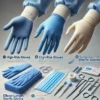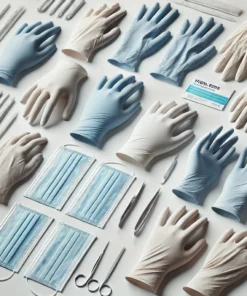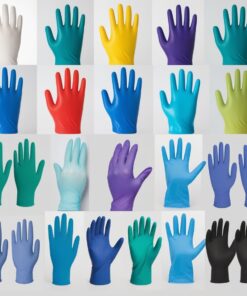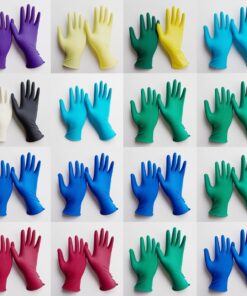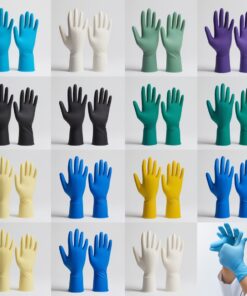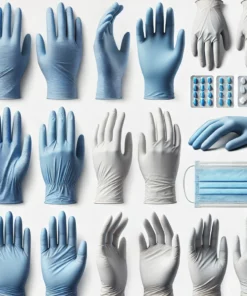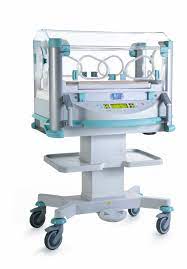Dermagrip latex chemo
R36,877.00 Ex VAT
In the medical field, gloves are an essential piece of personal protective equipment (PPE), ensuring the safety of both healthcare professionals and patients. There are various types of gloves used in medical settings, each designed for specific tasks and levels of protection. Among the most common types are nitrile gloves, latex gloves, and vinyl gloves. Each type offers unique benefits and is selected based on the requirements of the procedure and the potential exposure to infectious materials.
Laboratory high-risk exam gloves are specifically designed to meet the stringent demands of scientific research and medical testing. These gloves must provide exceptional protection against chemicals and biohazards while maintaining a high level of dexterity. Nitrile and latex options are commonly used in laboratories due to their excellent barrier properties and tactile sensitivity, allowing researchers to handle delicate instruments and samples with precision.
In a hospital setting, various types of gloves are used to protect healthcare workers and patients from contamination, infections, and chemicals. Below are the main types of gloves used in hospitals, along with their specific uses:
1. Nitrile Gloves
- Uses: Nitrile gloves are commonly used in medical settings because of their excellent resistance to chemicals, punctures, and infections. They provide a high level of sensitivity and are suitable for tasks that require precision.
- Applications: Used during examinations, surgeries, handling hazardous materials, and when working with patients with latex allergies.
2. Latex Gloves
- Uses: Latex gloves are known for their flexibility, strength, and comfort, providing a high degree of touch sensitivity. However, they can cause allergic reactions in some individuals.
- Applications: Primarily used for non-invasive procedures like physical exams, administering medications, and basic patient care where high tactile sensitivity is important.
3. Vinyl Gloves
- Uses: Vinyl gloves are made from synthetic material and are less elastic than nitrile or latex gloves. They provide a looser fit and are more affordable.
- Applications: Used for low-risk tasks such as cleaning, handling non-hazardous materials, or when there’s minimal risk of exposure to blood or bodily fluids.
4. Surgical Gloves
- Uses: These are sterile, disposable gloves specifically designed for surgical procedures. They are usually made of latex or nitrile and are highly durable to prevent contamination during surgery.
- Applications: Worn by surgeons and other healthcare personnel during invasive surgical procedures.
5. Chemotherapy Gloves
- Uses: These gloves are designed to protect against the harsh chemicals used in chemotherapy drugs. They are usually made of nitrile or other chemical-resistant materials.
- Applications: Used by healthcare workers administering chemotherapy drugs or handling hazardous pharmaceutical agents.
6. Neoprene Gloves
- Uses: Neoprene gloves offer good chemical resistance and are an alternative for individuals allergic to latex. They are resistant to heat and punctures.
- Applications: Commonly used in handling chemicals, cleaning, and lab work where chemical exposure is a risk.
7. Sterile Gloves
- Uses: Sterile gloves are used to prevent the transmission of germs and contamination in sterile environments such as operating rooms.
- Applications: Used during surgical procedures or in the handling of sterile instruments and environments.
8. Non-Sterile Gloves
- Uses: Non-sterile gloves are used when the risk of infection is low. These are commonly used in patient care situations that do not involve open wounds or high-risk exposure to bodily fluids.
- Applications: Used during routine examinations, handling equipment, and cleaning tasks.
9. Powdered Gloves
- Uses: Powdered gloves are coated with powder (often cornstarch) to make them easier to put on and remove. However, they are less commonly used due to concerns about allergic reactions and contamination risks.
- Applications: Occasionally used in non-sterile environments where quick and frequent glove changes are needed.
10. Powder-Free Gloves
- Uses: Powder-free gloves are preferred in most medical environments because they reduce the risk of contamination and allergic reactions.
- Applications: Used in surgeries, examinations, and procedures that require minimal risk of allergic reactions and contamination.
These types of gloves are critical in ensuring safety, hygiene, and preventing the spread of infections in hospital settings.
Related products
High gloves
High gloves
High gloves
High gloves
High gloves
High gloves
High gloves
High gloves

